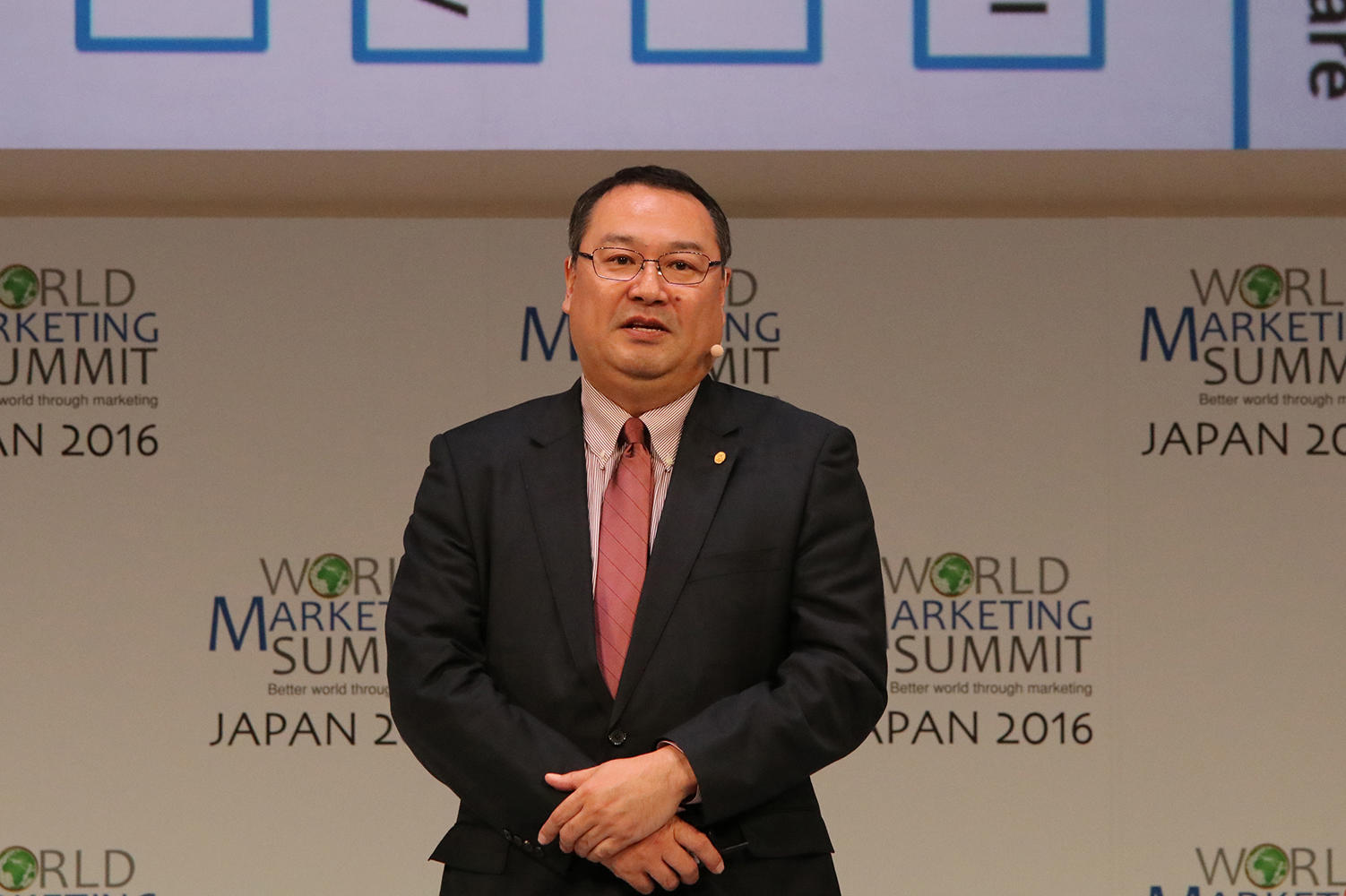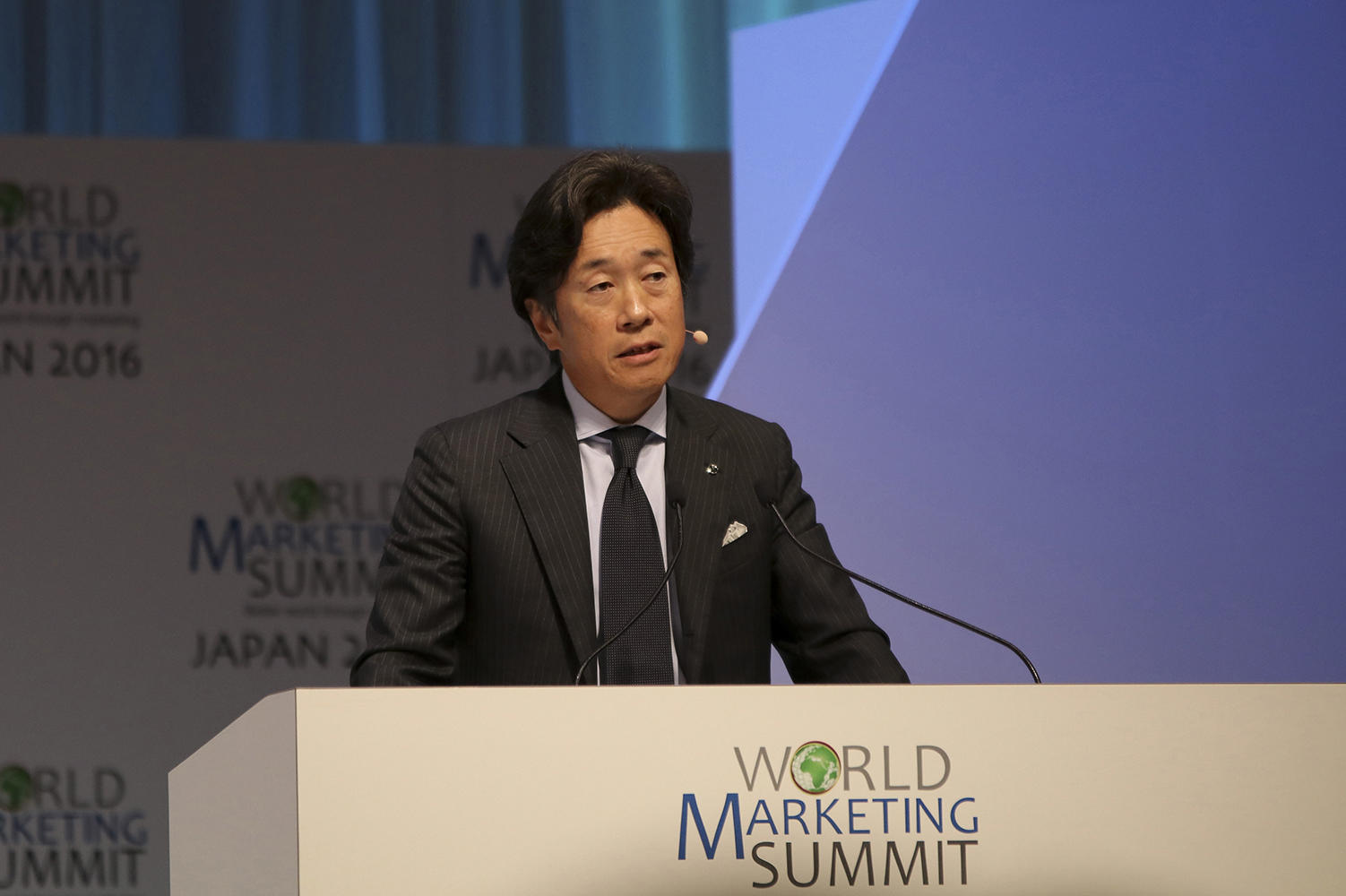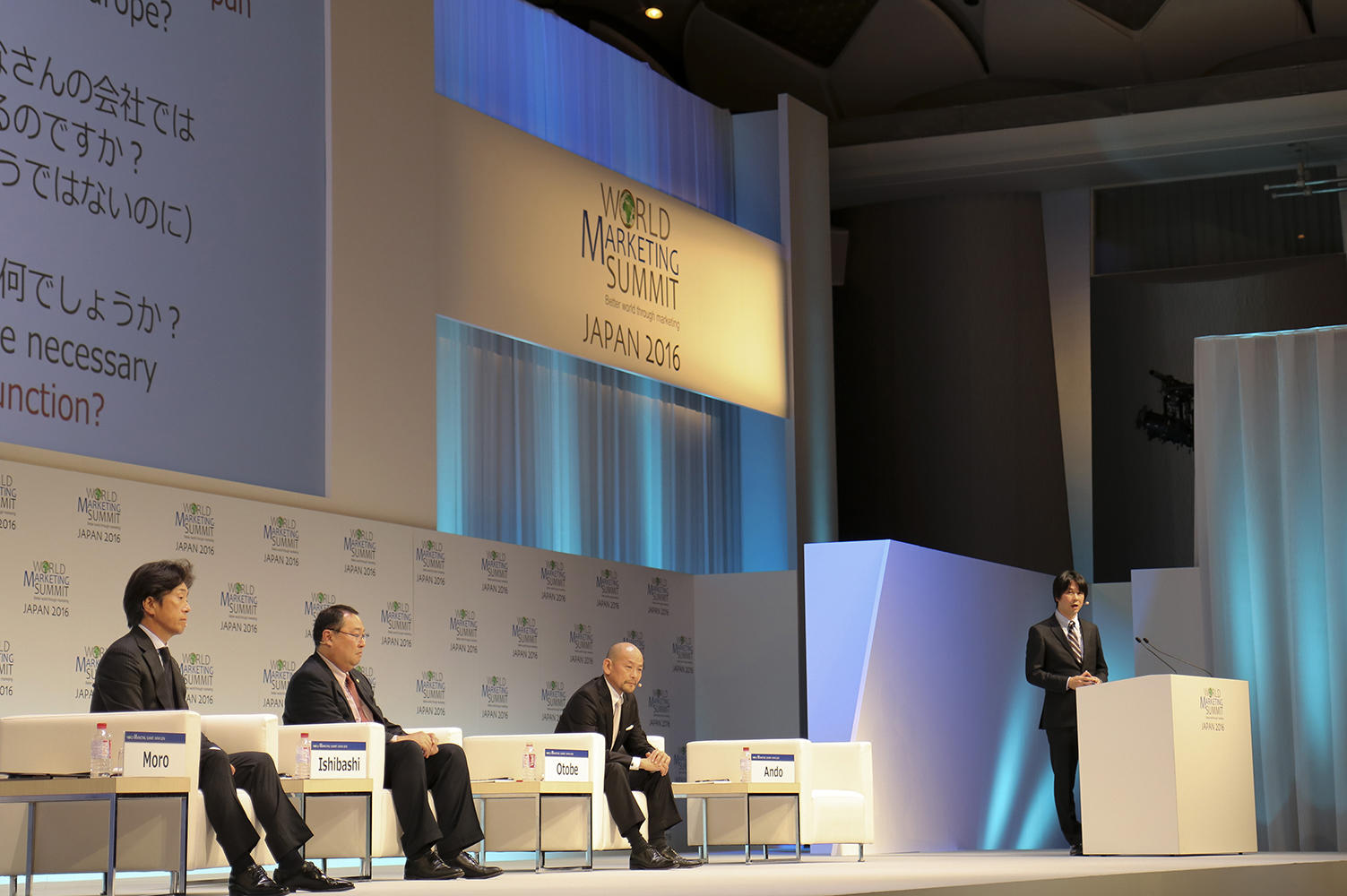- Events
The World Market Summit Japan was held over October 11 – 12, 2016. Hakuhodo planned and held an interactive session titled “The CMO in Japan” at this conference in front of a gathering of global marketing influencers. The session was moderated by Hakuhodo’s General Managere, Motohiro Ando, who welcomed three panelists: Daisuke Otobe, Chief Marketing Officer (CMO) of Shiseido Japan Co., Ltd., Masafumi Ishibashi, CMO of Nestle Japan, and Masahiro Moro, Senior Managing Executive Officer of Mazda Motor Corporation. The panelists discussed the responsibilities and roles of a CMO while mixing in questions from the audience. Observers say marketing is now a core issue for business management. Consequently, the ranks of CMOs, who are the central players in marketing, are expected to increase rapidly in the coming years. We reconvened this valuable session on the potential of and issues facing CMOs.

Session summary
The CMO in Japan
October 12, 2016 at Grand Prince Hotel New Takanawa International Convention Center, Pamir
Organized by the World Marketing Summit Japan Council
Panelists:
Daisuke Otobe, Chief Marketing Officer, Shiseido Japan Co., Ltd.
Masahiro Moro, Senior Managing Executive Officer, Mazda Motor Corporation
Masafumi Ishibashi, Chief Marketing Officer, Nestle Japan
Note: Titles current as of October 2016.
Moderator:
Motohiro Ando, General Manager, Hakuhodo
Creating a common language for marketing
Moderator (Mr. Ando) : Everyone in marketing today has heard of the position of chief arketing officer (CMO), but just five or six years ago, the term was not well recognized in Japan. A 2013 report put out by the Ministry of Economy, Trade and Industry stated that more than 60 percent of the U.S. corporations on the Fortune 500 had appointed a CMO. In Japan, however, a mere 0.3 percent of the top 300 corporations by market cap had instituted the same position. Admittedly, these figures were reported three years ago, and gradually more corporations in Japan have added CMOs. In this session, I would like to introduce three panelists who are CMOs or in an equivalent position to further the debate on the importance of the CMO and the CMO’s role.
Mr. Otobe : The work and mission of the CMO varies widely between corporations. Their responsibilities extend to achieving sales and profit targets, brand management, and, of course, the growth of the marketing organization. But what does growth of the organization mean? For me, I think of it as being able to do today what couldn’t be done yesterday. And what is the difference between “cannot do” and “can do”? What acts in this place is knowledge, writ large. The easier it is for in-house marketers to build up and accumulate knowledge, and to circulate that knowledge, the easier it is for the organization to grow.

Daisuke Otobe, Chief Marketing Officer, Shiseido Japan Co., Ltd.
Mr. Otobe : Let’s imagine a certain organization has 200 marketers. And these marketers belong to 10 separate groups, each of which is in charge of a different domain, like brand or media. We can express this division of 200 people into 10 groups as “20 x 10”. On the other hand, if you arrange your operations so that all the forms of knowledge these marketers have can circulate through a single organization, even as it maintains multiple groups, we can get “200 x 1”. Now let’s try an exercise. Let’s say all the marketers share the experience of every other marketer. In a small organization of 20 people, this comes to “20 x 20” which equals 400. And if there are 10 groups of this size, the total amount of knowledge circulated is “400 x 10” which is 4,000. But if we have an organization in which 200 people share a sense of unity, the formula works out to “200 x 200”, or 40,000. That’s a 10-times gain. You can see it in my calculation trick, but the obvious reality in corporations is that the 200 marketers have all kinds of experiences but are unable to share them. It follows that tremendous growth awaits the organization that can avoid brand or department silos and the disconnection of knowledge, that can encourage knowledge sharing, and that can establish a common language. In my opinion, realizing these elements is a key role of a CMO.
Spreading marketing approaches throughout the corporation
Mr. Ishibashi : At Nestle, we have departments called “functional units” that provide cross-divisional support to our category-specific business units. Functional units include the Marketing and Communications Headquarters, the Human Resources Headquarters, the Production Headquarters, the Supply Chain Management Headquarters, the Procurement Headquarters, the Financial Management Headquarters, and the Sales Headquarters.

Masafumi Ishibashi, Chief Marketing Officer, Nestle Japan
Mr. Ishibashi : I belong to the Marketing & Communications Headquarters. Marketing-related operations cover a wide gamut. This means our functional unit, possessing specialized marketing knowledge, supports all business units. I’m primarily in charge of operations involved with customer communications. This involves agency relations centered on media planning, digital communications centered on owned media, PR, market research, call centers, and many other aspects. If each business unit had to maintain all of these functions on their own, they would be bloated and hugely inefficient organizations. My role as CMO is to support business growth through better customer communications. I discuss with the business units what content is effective and what channels should we deploy over and then execute these decisions. Encouraging the growth of members in each business unit through routine business and training, and promoting the corporate brand, is also an important role of mine. We do not think of marketing as work solely for the marketing department. Marketing, for us, is about discovering customer problems and offering corresponding solutions. Innovation can happen when every department in the corporation is either engaging in marketing or using marketing-type approaches. This is our view.
Marketing as a business management issue
Mr. Moro : Mazda has seen continued global growth since we adopted brand-value management as a corporate management policy several years ago. Our brand value is pleasing customers with the fun of driving and the lively sparkle of life with a Mazda vehicle. Continuing to offer this kind of brand value, continuing to exist as a company people choose, and maintaining stable management — these are the basic precepts of brand-value management. Mazda had previously lost the trust of customers with a business philosophy inclined toward growth in terms of size. Brand-value management was a 180-degree pivot from our old business philosophy.

Masahiro Moro, Senior Managing Executive Officer, Mazda Motor Corporation
Mr. Moro : Before changing the company’s management policy, the senior management team first thoroughly debated brand-value management, as well as the marketing strategies to realize the company’s management principles. It’s interesting, however, the term “marketing strategy review” never came up in this process. That’s because we believed it was necessary to discuss sweeping away the idea of the marketing division as the lead entity and dismantling barriers. Next, with a framework for marketing strategies in place, we laid down product development strategies and business management strategies. A unique point for our company is that these two strategies function directly as marketing strategies supporting brand-value management. Recognition of our approach cumulated in winning the Grand Prize this year at the 8th Japan Marketing Awards. My position is to oversee marketing strategies, directed both inside and outside the company, based on brand-value management. Although my position is not called CMO, externally at least, my role is equivalent to a CMO. Specifically, my mission is to actualize the marketing strategy framework, established by everyone on the management team, for all sei-katsu-sha touch points, in domains such as sales, communications, and customer service, and to direct the global execution, proliferation, and monitoring of marketing strategies. My idea of the CMO’s role is drawing up blueprints to maximize value creation for customers from a management perspective, involving the entire organization in those structures, and having operations executed in line with management principles. I think it’s okay to have a diversity of CMO definitions. It’s only natural that the CMO position will vary depending on the business industry and management policies. There is a role common to all CMOs, however. That role is to connect marketing strategies to business management strategies, without limiting marketing strategies to just the creation of demand using sales and tools. I expect greater awareness of marketing will spur more discussion about CMOs.
Questioning the role of the CMO and its essence
Moderator (Mr. Ando) : Now we’ll start our interactive session. I’ll pick out a number of questions we received from audience members yesterday and have our panelists answer them.

Moderator: Motohiro Ando, General Manager, Hakuhodo
– Again, what is the role of the CMO? In particular, what about the CMO’s collaborations with other divisions and other C-suite executives?
Mr. Otobe : How involved should CMOs be in the execution specifics of marketing? That will vary between corporations, I think. But the idea that the CMO’s role is to create a framework for all of the corporation’s marketing initiatives is true for all corporations. Collaborating with other C-suite executives is a very important job for a CMO. That’s because aligning marketing directions among divisions is essential to defining individual brands and having each division buy into a shared brand vision.
Mr. Moro : As the person responsible for marketing, I have to keep in close contact with the key functions of the company, like development and business planning. I also have to coordinate with the IT division, as digital today is the business infrastructure throughout the company. Mazda puts an enormous amount of importance on sharing common aspirations and dreams throughout the company. Creating with other divisions the platform to share dreams and aspirations is a key job of the marketing head.
Mr. Ishibashi : My biggest time allotment goes to talking with business units and drawing up communication strategies. Next, after that, is dialog with the CEO.
– How is the advance of digital technology affecting the CMO’s role?
Mr. Moro : Many people the world over have smartphones and other digital tools and are connected digitally in the same way. This is a world humans have never experienced before. Business configurations and value chains are going to be transformed from the ground up, and I think we can agree that IT platforms will turn into marketing platforms. Digital and marketing will form an even closer relationship in the future.
Mr. Otobe : Take a fashion event like the Tokyo Girls Collection: More than 10 times the number of people actually in attendance experienced the event in real time with the Internet. It’s as if event marketing has been empowered by digital. And we’re seeing brands coming out nowadays that bake communications with users over the Internet into their branding process. I believe you cannot serve in the role of a CMO without insight into digital technology.
– Why are there so few CMOs in Japan compared with Western enterprises? What are the conditions for a CMO to function?
Mr. Ishibashi : The problem in Japan is that the definition of what is marketing is not firmly pinned down. Our marketing division is defined as the section with responsibility for sales and profit. Each corporation will likely have its own definition. What’s key, first of all, is to define marketing and then create an organization that corresponds with the definition. And what’s important is not appointing a CMO but looking at what is necessary to grow the business. Then if a CMO position is necessary, make one. That’s my preferred sequence of events.
Mr. Moro : I agree. Previously I implored our president to set up a CMO position. But he told me: “Think of what functions and roles are necessary rather than what titles.” That led me to the conclusion that the title CMO is not absolutely necessary. Historically, Japanese corporations have excelled at team management. Therefore, they are not exactly poor at sharing marketing issues with a variety of divisions. For example, manufacturing divisions think seriously about how they can provide value to the customer. That is the sharing of a marketing issue. The heart of the matter is fostering this kind of consciousness. Whether to set up a CMO position is a secondary problem.
Mr. Otobe : I, too, think the first priority is to clearly define marketing in your corporation. As a result of such internal discussions, you may find, for example, it’s important to carry out development and manufacturing processes within the marketing framework. And if it’s necessary to have a CMO to make these function, then appoint one. Seeing the question in this sequence is a good approach.
– Many of Japan’s automakers and electronics firms are engineering-oriented organizations. Marketing tends to be thought of as a narrowly defined position limited to advertising and sales promotion. What can be done in this case?
Mr. Moro : At my company, the development and manufacturing divisions have a huge presence. The way we made marketing a company-wide issue in such a climate was to spread the message of “let’s share the same aspirations and dreams” along with an awareness of marketing. If you can establish a common vision like this, then marketing will start to be recognized in a broader sense.
– Shiseido uses Shiseido as its umbrella brand and then places other brands under that umbrella. What is important when managing these two levels?
Mr. Otobe : We think of brands as meanings. Each brand has its own inherent meaning, as well as benefits that can be provided. We emphasize the presence of each brand to highlight its meaning. While, naturally, corporate branding is also important, our brand management is run based on an approach that separates the branding of individual products from corporate branding.
– What advice do you have for Japanese corporations considering adopting a CMO?
Mr. Ishibashi : I’m repeating myself, but it’s important to define marketing in a way that suits each corporation and then consider what sort of organization is best to execute that definition of marketing. How to create that organization, and how to manage it, are decisions for top management.
Mr. Moro : I believe marketing is the act of creating value and making the sei-katsu-sha who enjoy that value happy. The technical and manufacturing divisions of Japanese corporations tend to be strong, but their weakness lies in changing value into revenue. I think marketing strategies have significance when it comes to figuring out how to change this. Marketing strategies are extremely important to the continuance of a corporation. But adding a CMO by itself will not solve the problem. What is your vision, and how can you get everyone to buy into the vision? Everything begins with thinking about these questions.
Mr. Otobe : What would happen if your HR division disappeared? I think we can easily imagine that outcome. But what would happen if your marketing division disappeared? That scenario is much harder to envision. I believe the key mission of a marketing division is to create markets. The marketing division is indispensable to any corporation that needs a market-creation function. It follows, then, that the role of overseeing the division is also necessary. Again, the definition of marketing is more important than anything else.
Moderator (Mr. Ando) : So the problem is not whether to set up the position of CMO, nor whether to give someone the title of CMO. In the process of establishing marketing as a core business management theme and making it a company-wide effort, the role of the CMO becomes necessary. I think that is the common message from our panelists. I hope this session will deepen awareness of the issues surrounding CMOs in Japan and elsewhere.

This report is also available on the Hakuhodo Consulaction website. See here for details (in Japanese).













